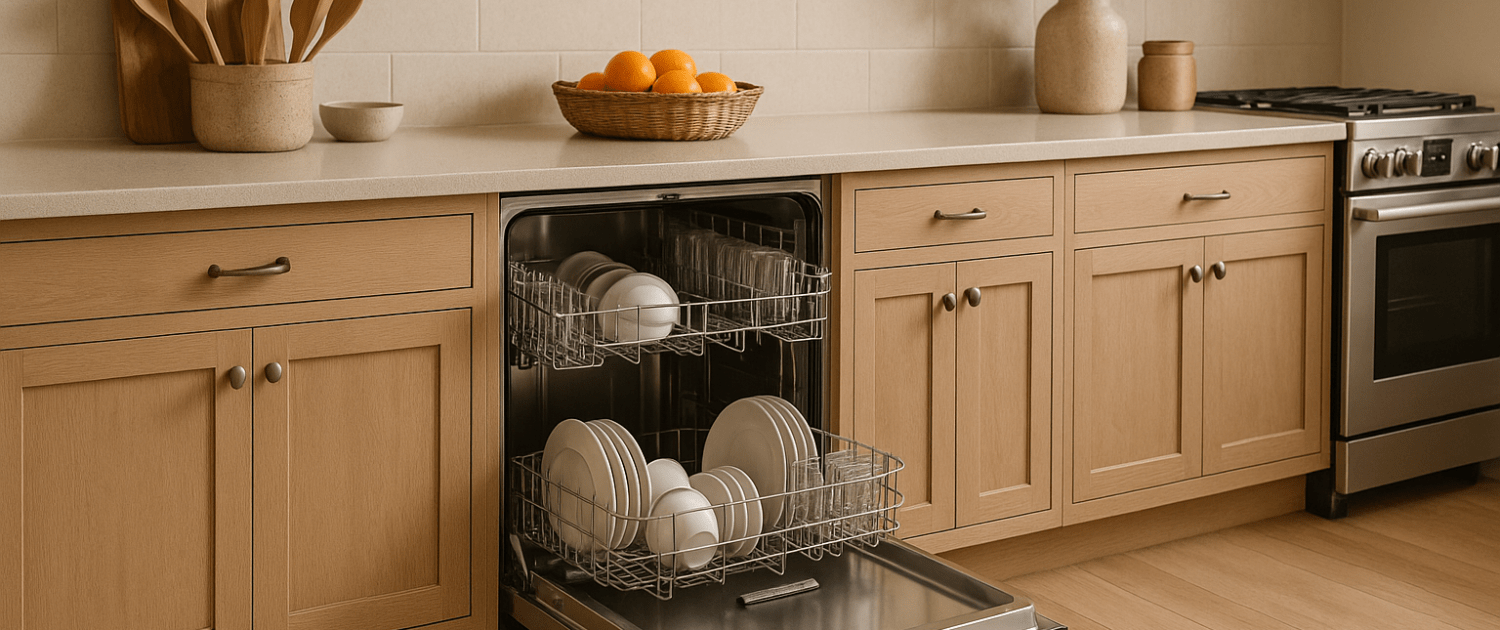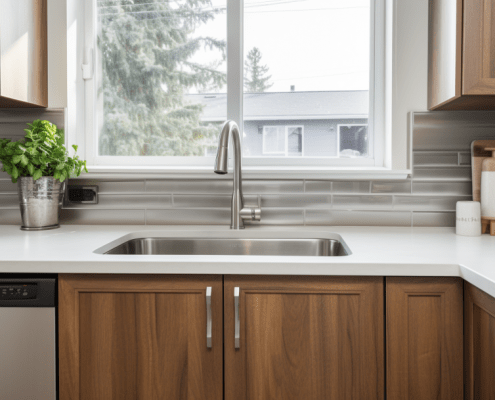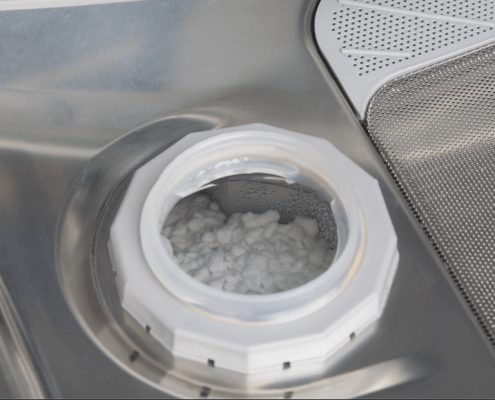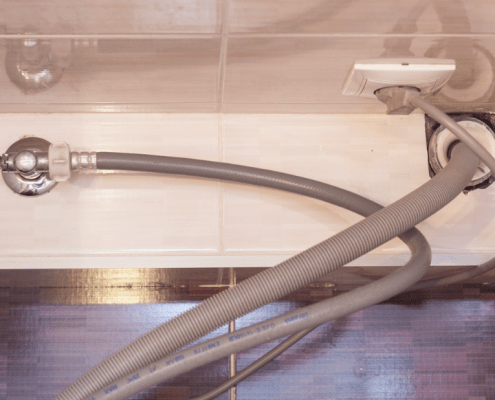How to Troubleshoot and Fix Error Code F112 on a GE Dishwasher
Steven E / Thursday May 22, 2025
If your GE dishwasher is displaying the F112 error code, it can be a frustrating experience. While it may seem daunting to diagnose and fix, we’re here to help you understand the common causes so you resolve the problem and get your dishwasher back in working order.
If you need any replacement parts for your appliance, you can enter your model number at AppliancePartsPros.com to order them. Most orders arrive in just two business days, and we have thousands of free guides to show you how to install your new parts.
The information in this article may not apply to your specific appliance model. We recommend consulting your manufacturer’s documentation or contact us with any questions.
What causes the F112 fault?
On GE dishwashers, the F112 fault code signifies that one of the push buttons on the user interface control is stuck or malfunctioning.
Under normal operation, a button’s electrical circuit is only closed momentarily when pressed. If a button remains closed longer than expected, the control interprets this as a stuck button and displays an F112 error. For example, if food or debris worked under a button keeping it pressed down, it would trigger this fault code.
Safety precautions
When working on any appliance, remember to keep safety first. Here are some tips to keep in mind:
- Always power off and unplug your appliance or switch off the circuit breaker before attempting any maintenance or replacement work. This keeps you safe by preventing any risk of injury from electric shock.
- Wear insulated work gloves to protect your hands from sharp metal parts, pinching hazards and debris.
- Take your time and don’t rush while working to prevent accidents and personal injuries.
- Work in a well-lit area so you can clearly see and access the interior parts.
- Clear your workspace of clutter and other obstacles. Keep children and pets away from the work area.
- Never work on internal parts with bare wet hands. Make sure the work area is completely dry.
- Check your user manual to see if there are specific installation or safety instructions for your part or appliance.
- Be gentle when handling or removing parts. Excessive force might damage the appliance or cause injury.
- Wear safety glasses when working with chemicals, dust or cleaning large debris to prevent injury.
- If the appliance has recently been used, give it plenty of time for any heating parts to cool down before working on it.
- Take pictures or make a note of wiring terminals or other connections before disconnecting to prevent any problems with reassembly.
- When working with wires, avoid touching any exposed wires or terminals. If you need to touch a wire, use a non-conductive tool or wear insulating gloves to prevent electrical shock.
- Turn off the water supply at the outlet before beginning repairs to any appliance parts that hold water. Have towels ready for any residual water in the system when removing parts.
Accessing the control panel parts
Disassembly
- Pull the appliance a few inches away from the cabinet to fully remove the door.
- Use a 1/4 inch socket or nut driver to remove the screws securing the lower access panel. Remove the panel and any insulation.
- If the power line and water supply line don’t have enough slack, shut off the water supply valve.
- Use channel lock pliers to unthread the water supply line fitting from the inlet valve.
- Use a 5/16 inch socket or nut driver to unthread the screw securing the junction box cover. Disconnect the wires.
- Disconnect the drain hose from the sink or garbage disposer and feed it through the cabinet.
- Remove the mounting bracket screws and adjust the legs to lower the appliance. Carefully pull the dishwasher away from the cabinet.
- Unhook the door cables, disconnect the door wire connector, and detach the wires from the retainer.
- Remove the upper and lower screws securing the hinges and slide them out.
- Remove the screws securing the inner door panel and slide it up to detach it.
- Disconnect the user interface wire connectors.
- Remove the four mounting screws securing the user interface board housing.
- Use a flathead screwdriver to pry off the light bezel and remove the interface board.
Reassembly
- Reconnect the user interface wires.
- Realign the inner panel and replace the securing screws.
- Reposition the hinges and replace the securing screws.
- Reinstall the door, reconnect the cables and wires.
- Gently slide the dishwasher back into the cabinet and adjust the leveling legs.
- Secure the mounting brackets and reconnect the drain hose.
- Reconnect the water supply line and replace the insulation.
- Reposition the lower access panel and secure it.
- Turn the water and power back on.
Troubleshooting steps
Step 1: Perform a power cycle
- Unplug the dishwasher from the power source and wait for at least 60 seconds.
- Plug the dishwasher back in or restore power to the circuit.
-
Observe the dishwasher’s behavior and check if the error was temporary and has been cleared.
- Inspect the control panel buttons to ensure they are functioning properly. Press each button firmly and check that the corresponding action is triggered on the dishwasher.
- Gently clean the buttons using a soft, damp cloth to remove any debris or buildup that may be interfering with their operation.
Step 3: Inspect the console and light pipe
- Examine the dishwasher’s console, where the control panel is located, for any signs of damage or discoloration.
- Check the light pipe, which is responsible for transmitting the indicator lights from the control board to the console. Ensure the light pipe is properly seated and not cracked or broken.
- If the console or light pipe appears damaged, they may need to be replaced.
Step 4: Test the user interface (UI)
- If the buttons and console appear to be in good condition, the issue will be with the user interface.
- Use a multimeter to check for continuity between the UI connectors and the control board. Refer to the wiring diagram in your owner’s manual to identify the correct test points.
- If the UI is not functioning properly, it will need to be replaced.
Step 5: Replace the User Interface (UI)
- Purchase a replacement UI assembly that is compatible with your specific GE dishwasher model.
- Install the new UI assembly by reconnecting the wires and securing it in place.
- Restore power to the dishwasher and test the new UI to ensure it is functioning correctly.
More information
Thank you for reading! We hope you found this information useful to get your dishwasher working again.
If you have any other appliance repair needs or projects, don’t hesitate to explore our thousands of free videos and troubleshooting guides available. If you need replacement parts or some extra help, grab your model number and head over to AppliancePartsPros.com, where you can chat with a pro, order parts, read our DIY blog, and more.
Be sure to subscribe to us on YouTube and follow us on Facebook, Twitter, and Instagram!
With nearly a decade of experience in providing top-notch customer service regarding appliance parts and repair, Steven enjoys sharing practical advice, troubleshooting tips, and interesting information to help readers stay informed.





